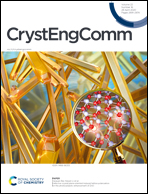Heterobimetallic complexes from 0D clusters to 3D networks based on various polycyanometallates and [Cu(dmpn)2]2+ (dmpn = 2,2-dimethyl-1,3-diaminopropane): synthesis, crystal structures and magnetic properties†
Abstract
Six novel heterobimetallic cyanide-bridged complexes formulated as {[Cu(dmpn)2]2[Fe(bpb)(CN)2]}[Fe(bpb)(CN)2](ClO4)2·2H2O (1), [Cu(dmpn)2][Fe(bbp)(CN)3]n·0.5nDMF·2.5nH2O (2), {[Cu(dmpn)2]1.5[Cr(CN)5(NO)]}n·3nH2O (3), {[Cu(dmpn)2]2[Fe(CN)6]}n·10nH2O (4), {[Cu(dmpn)2]4[Mo(CN)8]2}·CH3CN·2H2O (5), and {[Cu(dmpn)2]4[W(CN)8]2}·CH3CN·2H2O (6) (bpb = 1,2-bis(pyridine-2-carboxamido)benzenate, bbp = 2,6-bis(benzimidazoi-2-yl)pyridine, dmpn = 2,2-dimethyl-1,3-diaminopropane, DMF = N,N-dimethylformamide) were synthesized with one amine copper compound as an assembly segment and six polycyanometallates containing two, three, five, six or eight cyanide groups as building blocks. All of the six complexes have been characterized using elemental analysis, IR spectra, and powder and single crystal X-ray diffraction. Structural analysis revealed diverse structural types of complexes 1–6, ranging from discrete polynuclear entities (1) to a 1D single chain (2) to 2D (3, 5 and 6) and 3D (4) networks, clearly indicating the important role of the building block in tuning the structures of the target complexes. The magnetic properties of the reported cyanide-bridged complexes have been experimentally studied and theoretically simulated, disclosing ferro- or antiferromagnetic coupling between the low spin Fe(III) ion and Cu(II) ion and the antiferromagnetic interaction between the Cr(I) ion and the Cu(II) ion through the cyanide bridge. Furthermore, the nature of the magnetic coupling has been analysed based on the magneto-structural correlation.
![Graphical abstract: Heterobimetallic complexes from 0D clusters to 3D networks based on various polycyanometallates and [Cu(dmpn)2]2+ (dmpn = 2,2-dimethyl-1,3-diaminopropane): synthesis, crystal structures and magnetic properties](/en/Image/Get?imageInfo.ImageType=GA&imageInfo.ImageIdentifier.ManuscriptID=D0CE00235F&imageInfo.ImageIdentifier.Year=2020)


 Please wait while we load your content...
Please wait while we load your content...